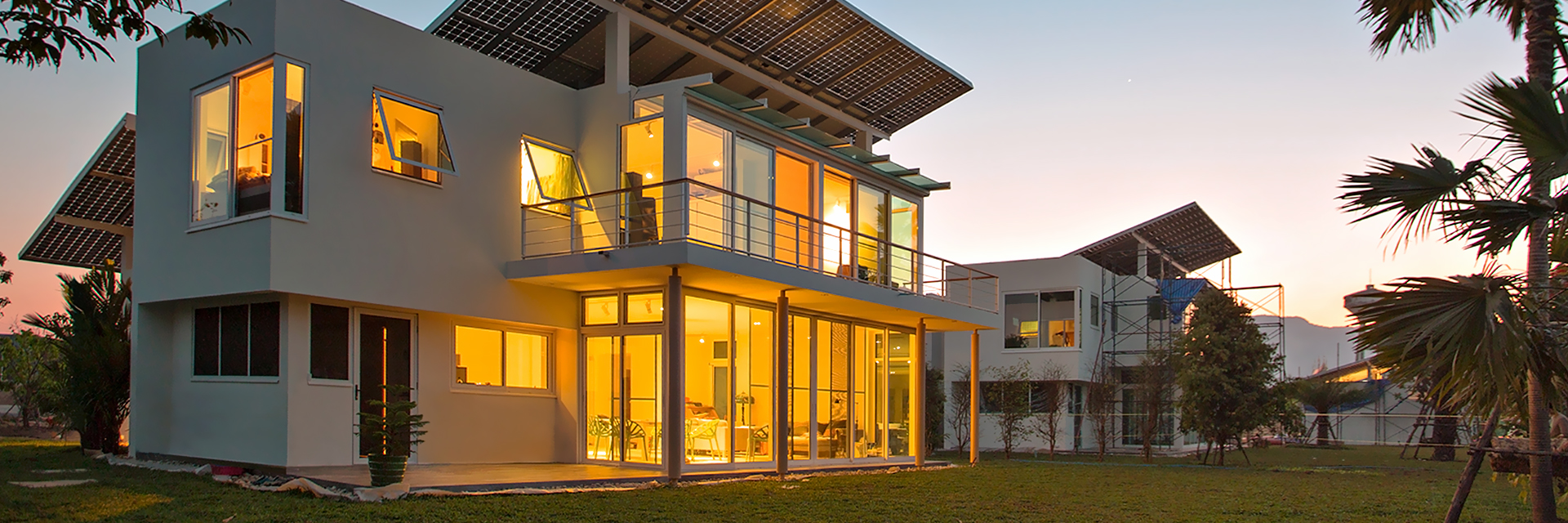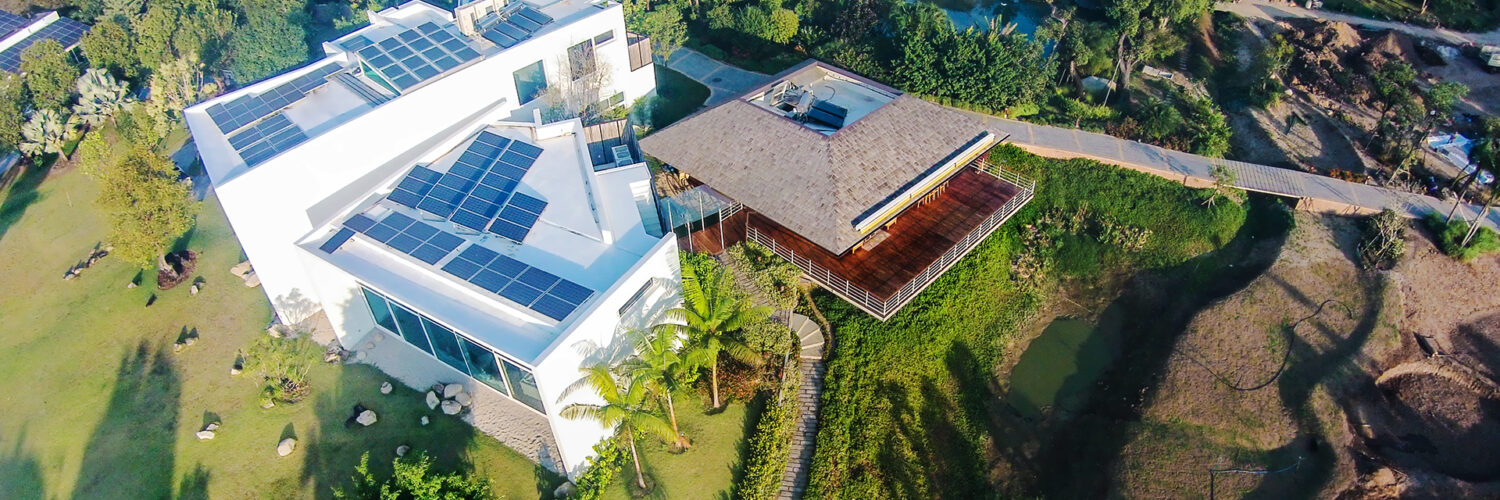Phi Suea House — The Enapter Story
How the “House of Butterflies” gave rise to the world leader in AEM Electrolysers
Agosto 23, 2022

More and more people are becoming aware of Enapter’s mission to make green hydrogen production affordable, accessible and scalable – and of the game-changing AEM Electrolysers that are allowing us to do so. But far fewer know the full, fantastic story of how Enapter came to be. To trace our green hydrogen company back to its origins, we have to skip back 18 years to the jungle-clad hills of Chiang Mai, Thailand.
From software to self-sufficiency
Sebastian-Justus Schmidt and his young family had just arrived in Thailand’s mountainous north. The former Siemens management trainee and organisational programmer from Germany had been at the helm of multiple IT companies, and in 2001, he and friends had started one of the first globally-successful mobile software companies, SPB Software. As SPB’s CEO, he moved to Asia in 2004 to be closer to customers, joined by his wife Erika and their three children. Sebastian chose Chiang Mai thanks to its convenient flights all over Asia for work, but they fell in love with the city, sold their home in Hamburg and settled in.
Ten years later, as Sebastian stepped back from leadership roles, he finally had time on his hands to build a home in Chiang Mai. And the Schmidts wanted to make it as sustainable as possible to give back to the country that had welcomed them wholeheartedly as newcomers – and with the knowledge that we are all guests on this planet.
He dove into research, identifying the elements to piece together in the emerging puzzle – solar power, permaculture, sustainable building materials with a secured path for recycling, systems for water circulation and so on. Experience working with the telecommunications industry had shown him how useful self-sustaining energy systems could be, and he wondered how solar could provide reliable power even through Chiang Mai’s rainy season. What energy storage system could help build their dream?
Home is where the hydrogen is
Solar power was an obvious electricity generation choice, but to store this energy, Sebastian wanted to find a more sustainable option without the environmental drawbacks of lithium batteries. Deeper down the rabbit hole he went. At the CommunicAsia expo in Singapore in 2014, he by accident chanced upon the stand of a small Italian company, ACTA. Their focus: electrolysers for green hydrogen production for telecom tower stations.
ACTA had been founded in 2004 when a team of engineers embarked on an R&D mission to leverage hydrogen technology for modern electrical grids. In 2007, they turned their attention from fuel cells to Anion Exchange Membrane electrolysers (AEM for short). This tech piqued Sebastian’s curiosity and he was soon convinced by the promise of green hydrogen – and even more tempted when he found that no-one had ever created such an energy system on a multi-house scale. Some people buy a Ferrari, Sebastian decided to buy electrolysers.
Assembling a team of local talent, including Sebastian’s son, Jan-Justus, the ambitious project went from plan to reality in little over two years. Its crowning centrepiece: green hydrogen generation and storage systems supplied by ACTA.
A self-sustaining world first
At the start of 2015, it became the world’s first self-sustaining multi-house residence powered by an H2-based clean energy system. Constructed with energy-efficient design principles, it has an energy building, two guest houses, the main family house, a workshop, and a separate main kitchen and terrace. It uses natural air flow for cooling, a smart control system boosts convenience and energy saving, water is caught and treated in a submerged drainage and filtration system, and hundreds of trees in the organic garden attract the wildlife that gives it and the surrounding sub-district its name – Phi Suea (Butterfly) House.
Solar panels supply its daytime energy demands, and any excess electricity generated flows to the hybrid battery-hydrogen energy storage system. Here, electricity and water are turned into green hydrogen during the day using AEM electrolysers, with fuel cells converting hydrogen back to electricity when needed. The batteries (lead-acid gel with full recycling guarantee) are used to balance daily demand, while the H2 lets the system provide seasonal storage – reliably meeting a monthly demand of about 6 MWh all year round.
Over time, Sebastian became more and more convinced of the potential of hydrogen tech, and despite some challenges experienced with the green hydrogen systems, he realised that the core technology of the AEM electrolysers was very reliable. Moreover, he saw the potential to rethink electrolysers as mass-manufactured products and scale up production. He scoured hydrogen exhibitions across Europe and Asia, looking to acquire a company with the right attitude and interest to take modular electrolysers to the big-time.

“En” like Energy, “apter” for adapting
By this point, ACTA had run into financial issues, and after filing for bankruptcy protection, its stakes went to Germany’s Heliocentris Energy Solutions AG, and finally to UAE’s Odasco, which started to breathe life into the Italian firm, only to stop weeks later. That’s when Sebastian got the offer for majority shares.
October 30, 2017. Sitting in a hotel room in Berlin after a day completing due diligence on the company, Sebastian was about to say no – despite the tech’s potential, the company was in poor shape. While watching the evening news, a report came on: CO2 concentrations were rising despite the urgent need to cut them drastically. He couldn’t sleep. That night he called friends to ask for opinions. He called Jan to ask if he believed they could shape the right team to turn the company around – and seize the fossil fuel fighting opportunity offered by green hydrogen. Answer: Yes. Deal: Signed. Game on.
Sebastian renamed the company Enapter (“En” like Energy and “apter” for adapting), taking over the existing site near Pisa, the core technology, patents and the electrochemistry team. Alongside Jan and Sebastian was another co-founder, Vaitea Cowan from New Caledonia, whose burning ambition to fight climate change had led her to Phi Suea House. Her experience working alongside the Schmidts there and in the software industry bolstered their marketing, events and outreach capacities. They began to grow Enapter at pace, and hired more staff in Pisa, contracted software developers – knowing that software is crucial for the future of energy – opened a Berlin office in 2019 (led by Vaitea) and reached more than 200 employees by July 2022.
Enapter’s technology also advanced, with electrolyser prices dropping steeply, performance improving, module size decreasing and global uptake growing. This rapid development continues as construction of the ‘Enapter Campus’ mass production site and additional R&D centre picks up speed. R&D is an Enapter focus: Hydrogen tech, in general, is still young and the companies winning the race will have better R&D, top execution and the best organisation, not just the best modular electrolyser. Sebastian believes that Enapter, with its patented AEM tech, will reach the lowest green hydrogen price possible.
A green lighthouse
But the Phi Suea House story didn’t end with its opening: As the finishing touches were made, the first guests arrived to experience the hydrogen future. Since then, more than 1,000 people from all parts of society have stayed. They take away the impression that sustainable living doesn’t mean sacrificing comfort, that cooling is largely possible without air conditioning (using a traditional Thai approach) and that Chiang Mai has a glimpse of the energy future seen nowhere else. University groups have also visited to see the possibilities of green hydrogen – and tasted them, thanks to sweet treats baked with hydrogen power.
The Phi Suea House became a hub of hydrogen activity, hosting events like the Hydrogen Energy Summit 2018, before being singled out as a Hydrogen Valley – one of the world’s most advanced hydrogen projects – by the European Union’s Mission Innovation Hydrogen in 2021. Sebastian believes Thailand, with its abundant sun and many islands, can become a lighthouse nation for green hydrogen microgrids eliminating diesel use. The Phi Suea House will be an advocate for this in Thailand, Southeast Asia and beyond. As electrolyser production costs and renewables prices continue to fall, such projects will become the standard, not the exception. But climate change is so urgent that we must look beyond hydrogen microgrids.
Thus, the Phi Suea House will grow into a prototyping sandbox for the hydrogen future, a testbed for trialling and implementing bold sustainable hydrogen technologies of all stripes. It is in close contact with Southeast Asian universities, energy companies, utilities and other stakeholders on new projects. It also supported the event formerly known as “Generation Hydrogen” , which gives those passionate about trailblazing green hydrogen technology a platform to raise their voices, help each other and crack energy transition challenges. Hydrogen systems must seamlessly integrate into different use cases, and many technologies and software will be the key for this. The Phi Suea House is where many of these ideas will come to life.
We’ve come a long way in a short time, but the Enapter story is just starting. So far, we have delivered 3,700+ AEM Electrolysers across the globe catering to all imaginable green hydrogen applications.
Do you also have a green hydrogen project in mind?
Then request a quote for our modular AEM Electrolysers, meeting your needs from kW scale to the MW range now.
